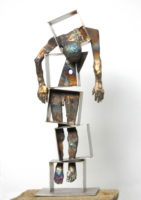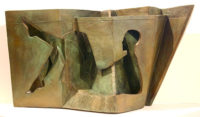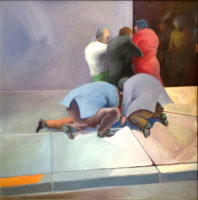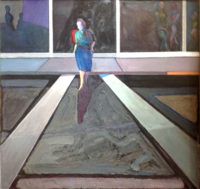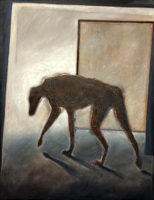Generations: Enrique Montenegro, Ernesto Montenegro, Philip Montenegro
Ernesto Montenegro
“Growing up in the 60s, I was influenced by my father, Enrique Montenegro, an abstract expressionist who shared recognition with Richard Diebenkorn in a 1957 Life Magazine article of up-and-coming painters of the American West. Like my father, I started out as a painter, but I found myself drawn to three-dimensions and bronze. In 1959, my family moved to Austin, Texas where my parents sent me to sculpture lessons. At 18, I wrote Henry Moore to ask if I could apprentice to him. He suggested I get more experience, so at 19, I moved to NYC to work as an apprentice granite stone carver. In my 20s, I moved to Boston where the director of the Boston Center for the Arts commissioned me to paint a 65-foot mural in his home. I went back and forth between two and three-dimensional art until 1988, with my first public commission in Cambridge, Massachusetts, when I chose to focus on bronze sculpture. My artistic ‘world view’ sees profound beauty everywhere, yet being naturally suspicious of conventions I take nothing for granted. The idea of branding seems antithesis to the true nature of an artist, or at least what I consider to be an artist. I am always searching, exploring, and experimenting with new ideas, genres and even mediums. For me, art is a journey of discovery, whether it manifests itself by extracting the life force of the City in which I live, as in the series, City Scenes or by following the intriguing suggestion of shadows as a metaphorical spirit world in the series Gallery of Shadows. As humans, we constantly find ourselves running up against life’s trials and challenges, and in the series flatmensquared, I find expression in figures that reveal themselves within the confines of rigid boxes. My bronze work centers on the figure, yet instead of simply replicating the beauty of the human form, I attempt to interpret the figure in slant and different ways. I have completed many individual bronzes and three bronze series: ‘City Scenes’, a series depicting human encounters with the mechanics of metropolitan life: i.e., a crosswalk, rush hour, traffic island, etc.; Gallery of Shadows, a series with gouged out relief images, wherein negative space defines the form; and most recently, ‘flatmensquared,’ a series in stainless steel and bronze, where fragments of the figure reveal themselves within the confines of rigid boxes that express our human condition within varied and restricted realities. Work from these series and bronzes not part of any series are all manifestations of my journey as an artist.”
29x11x9.5 in
14.5×25.5×7.5 in
See more of Ernesto’s work here.
Enrique Montenegro
Enrique Montenegro was born in Valparaiso, Chile. After moving to the United States in his early 20s, he earned a BFA from the University of Florida in 1944, and studied further at the Art Students League in New York. Montenegro taught painting at several schools, including Brown University, Penn State, and the University of New Mexico (1946-1952). As both a painter and a teacher Montenegro’s influence was wide-ranging, and left a mark on a legion of painters, draftsmen, curators, and art historians alike that were to form the next generation of artists.
As a painter his style was unique and varied. Initially, he belonged to the dynamic movement of the Abstract Expressionists, but was to go on to develop his own visual language that translated into landscapes, tablescapes, and figures with forceful, “muscular” tension articulated by masterful brushstrokes and sensitive color schemes. Later he was to blend this unique language with classical technique to express social commentary on the tumultuous American scene comprising the years between the sixties and the end of the twentieth century.
49×50 in
49×52 in
Philip Montenegro
“I was fortunate enough to grow up in a family of artists, surrounded from day one by the vibrant, expressive paintings of my grandfather, Enrique Montenegro, and the dynamic sculptures of my father, Ernesto Montenegro. Like my father and grandfather, I am drawn to the innate strangeness and wonder underlying the seemingly ordinary.
In high school I became passionately focused on cartoons, comics, and illustration. Drawing became a necessary outlet for translating my adolescent lens of the world. Teenage drama and national conflicts were equal fodder through the interpretation of my pen. My love for drawing led me to the New Hampshire Institute of Art in Manchester, New Hampshire. Initially, I majored in illustration, but soon found the painting program more enticing for its focus on method and technique. In senior year of art school, students were asked to create and curate their own bodies of work which connected to a theme in their Capstone Paper. I chose poetic acts of bravery. Using figure narrative oil painting on canvas and wood, I endeavored to translate temporal moments of bravery such as Philippe Petite, the wire-walker, crossing between the Twin Towers and Vedran Smailovic playing his cello in the bombed out national library of Sarajevo for my paintings. In my award-winning capstone, I connected these acts of bravery with the choice of becoming an artist. I am honored to join my father and grandfather in a multi-generational art show using my paintings as part of this legacy and as a means to contribute to an ongoing dialogue with these two family members. Above all, I believe that the paintings must speak for themselves; or, as one of my instructors said, ‘they should be the most eloquent.'”
77×36 in
60×48 in

